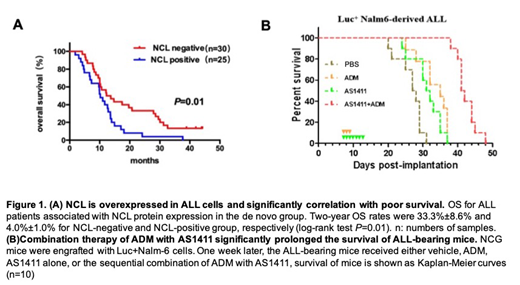Chemotherapy resistance is considered to be the principal cause of ineffective treatment in acute lymphoblastic leukemia (ALL). Nucleolin (NCL) is high expression andplays oncogenic roles in most cancers. However, less research on the role of NCL in hematologic malignancies was noted. Our previous studies have showed that overexpression of NCL was associated with worse prognosis in the patients with acute leukemia and NCL expressionwashigher in resistant HL-60/ADR than in sensitive HL-60 cells. The potential mechanisms of NCL in chemotherapy resistance have yet to be revealed. Here we presented that expression of NCL was associated positively with chemotherapy resistance and poor prognosis in ALL. Overexpressed NCL at both mRNA and protein level was relevant to a poorer overall survival (OS) and relapse free survival (RFS), indicating NCL as an independent prognostic marker in ALL. mRNA level of NCL in de novo ALL was quantitatively higher than in complete remission(CR) status, and refractory/relapse ALL had the highest level. Upon above clinical data, we further investigated the mechanism(s) by which NCL regulated drug resistance in ALL cells. Remarkably, NCL expression was higher in resistant ALL cells relative to sensitive parental cells. When treated with ADM, NCL level was decreased in sensitive parental cells while unchanged in resistant cells. Overexpressing NCL suppressed drug sensitivity, altered drug effluxion and decreased intracellular drug accumulation, while inhibition of NCL led to a completely reversed appearance, more intracellular Adriamycin(ADM) mean fluorescence intensity (MFI) and percentage of ADM accumulated cells population. Overexpression of NCL increased significantly the IC50 of ADM. The IC50 of ADM on Jurkat-NCL-overexpression(OE), Jurkat-NCL-knockdown(KD), Molt-4-NCL-OE, Molt-4-NCL-KD, Nalm-6-NCL-OE, Nalm-6-NCL-KD were 1.362±0.271μg/ml, 0.077±0.010μg/ml, 4.863±0.733μg/ml, 0.081±0.018μg/ml, 0.237±0.042μg/ml and 0.046±0.002μg/ml, respectively (P <0.05). Involvement of ATP-binding cassette (ABC) transporters was proved in NCL mediated drug resistance. Silencing NCL resulted in a decrease of P-gp, MRP1, LRP and BCRP in ALL cells, and NCL overexpression increased the MRP1, LRP and BCRP. The Akt/mTOR and ERK signaling pathways were involved in this procedure. Notably, co-IP assays confirmed the NCL-Ras, NCL-ERK and NCL-BCRP interaction. For intervention study, aptamer AS1411, a NCL inhibitor, could reduce drug resistance in ALL cell lines and primary ALL cells.Moreover, AS1411 treatment decreased BCRP protein expression. Furthermore, the ALL leukemia models that nude mice engrafted with Nalm-6 cells and NCG mice engrafted with Luc+ Nalm-6 cells were established, then treated with ADM plus AS1411 or control CRO for comparison drug sensitivity and survival. Growth of subcutaneous xenograft tumors was inhibited in those treated with AS1411 or ADM, compared to their respective controls treated with CRO or PBS. The stronger inhibition effect was observed in those treated with AS1411 combined with ADM. For Luc+Nalm-6 derived ALL model, leukemia progression was suppressed in mice treated with AS1411 and AS1411 combined with ADM. AS1411and ADM, especially combination of AS1411 and ADM, could improve survival of the leukemic mice compared to those treated with PBS. The results showed that NCL targeted by AS1411 sensitized ADM treatment and prolonged survival in vivo. In summary, our findings revealed NCL as a survival predictor and the novel role of NCL in ALL chemo-resistance. NCL may be a potential target for improving outcome in ALL.
No relevant conflicts of interest to declare.
Author notes
Asterisk with author names denotes non-ASH members.


This feature is available to Subscribers Only
Sign In or Create an Account Close Modal